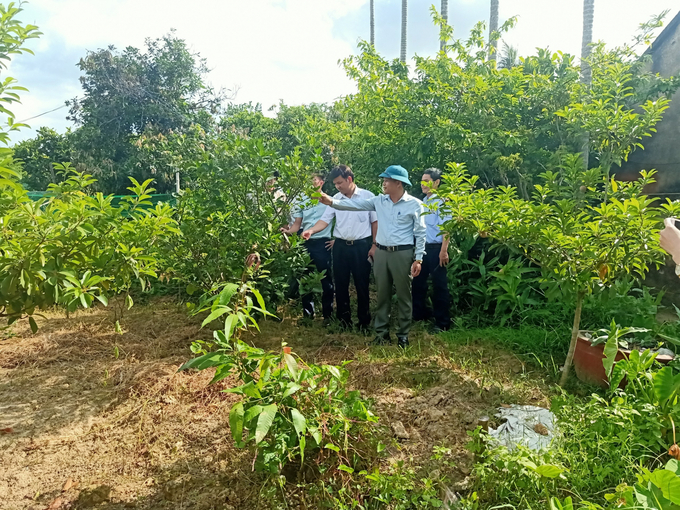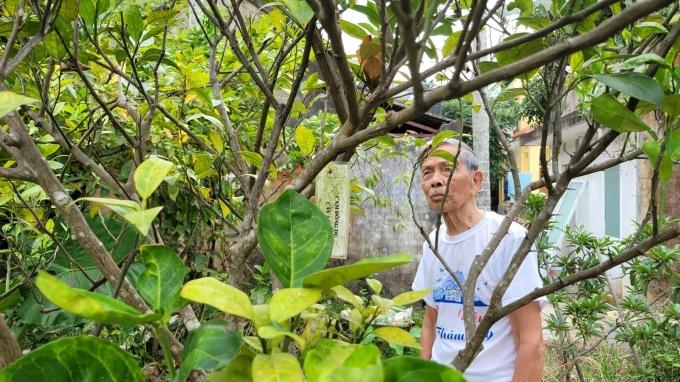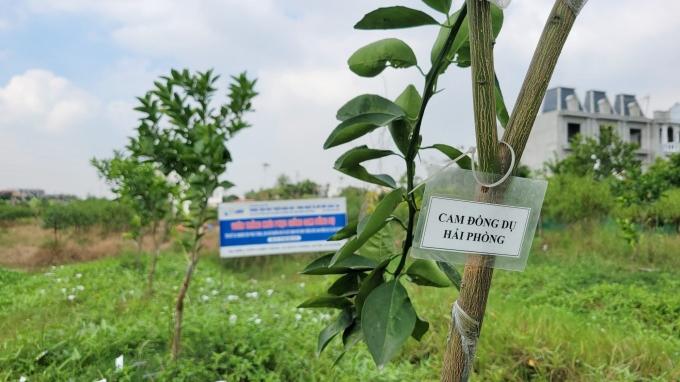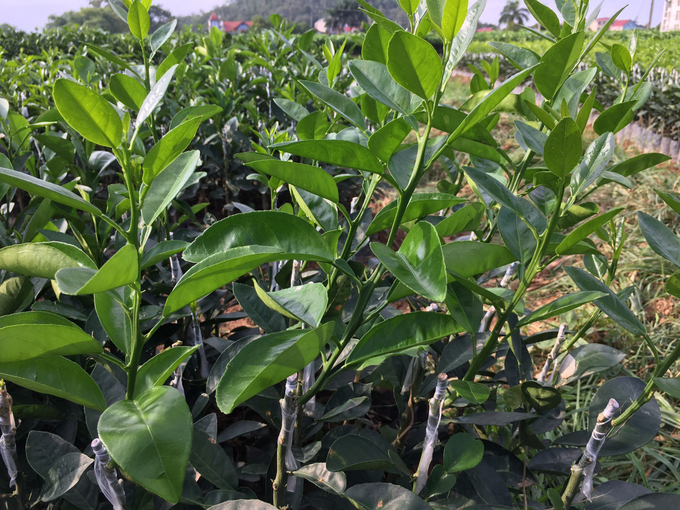Precious from the Tran Dynasty
According to studies, in Dong Du Village, Dang Cuong Township, An Duong District, Hai Phong City, the orange variety is one of the most valuable orange varieties, planted about 800 years ago from the Tran Dynasty with two species, lemon oranges and oranges.
Lemon oranges in particular have high walls, thick skin, and there is a rounded area at the bottom of the fruit, hence it’s called a “coin” orange. Lemon is the size of a teapot, small, slightly pink, juicy, sweet in taste, bright yellow when ripe.

Professional agencies appraise the rare Dong Du orange tree in Mr. Nguyen Sinh Xuy’s garden, Dang Cuong Township. Picture: Dinh Muoi.
Like sugar oranges, the fruit is small, with a tea cup, low wall, thin peel, many aromatic oils, when ripe like a paper orange, when eaten, orange has a sweet, mellow taste, is a product that uses becomes king in order to advance.
According to local people, Dong Du orange bears 5-7 fruits/tree in the first harvest, then the number of fruits gradually increases, until maturity, it gives 50-70 fruits/tree/year, and bears fruit continuously for dozens of years . Year.
Previously, in order to promote the king, the village organized the order of villagers to plant and select oranges to professionals, growers, breeders and caretakers.
In the fertilization stage, people use soybean meal and soaked hibiscus casings to fertilize the plants. The Orange Selection is performed on the occasion of the Lunar New Year by elders and dignitaries chosen to rise to the rank of king. From a staple kind, a specialty that advanced the king, in the mid-1990s of the 20th century, for many objective reasons, the whole village of Dong Du had only more than 10 households growing these two varieties of orange.
Over time, the sugar oranges disappeared, until 2004 only 20 citrus trees remained. At that time, the local government was striving to find and then set up a Dong Du orange variety recovery project with 12 participating households.

Mr. Nguyen Sinh Xuy and one of the remaining old and weak orange trees. Picture: Dinh Muoi.
However, because people did not apply the right technical process, the project went bankrupt, people changed the structure of the plants, most of the garden areas and fields were planted with begonias, ornamental peaches, etc. This tree has a higher economic value.
“Two varieties of Dong Du orange are delicious, but they suffer from pests and diseases and cannot compete with other famous orange varieties, leaving many households uninterested. By 2020, the whole village will only have 3 trees in my garden, of which 2/3 of the orange trees are weak, have many diseases, the largest tree is over 20 years old and showing signs of fading. Fortunately, the orange variety was saved at that time,” said Mr. Nguyen Sinh Xuy, 90, who lives in Dan Hanh Village in Dang Cuong Township.
Expected to become a product OCOP
Nguyen Van Toan, head of the An Duong District Ministry of Agriculture and Rural Development, said that in the face of the “red alert” situation, the loss of valuable orange varieties in order to maintain the economy, preserve and develop famous specialties of the community and the Ortes, Mr. Local authorities and functional sectors have made a proposal to the Hai Phong Ministry of Science and Technology on the preservation, storage, propagation and development of Dong Du orange variety.
At the end of 2020, the Science, Technological Development and Innovation Center (under the Hai Phong Science and Technology Department) came to check the plant and take 100 eyes to propagate, expecting that it will recover, to develop the new plant. and creating a brand for cultivation areas and key products of Dang Cuong Village.

The first successful grafts. Picture: Dinh Muoi.
The research team extracted branches from orange trees in Mr. Xy’s garden and grafted them onto 40 healthy grapefruit trees to build a native orange garden to prevent extinction.
Grafting oranges onto grapefruit roots has been used successfully in many places, this breeding technique is inexpensive, saves labor, and has few pest and disease seedlings and strong growth.
Besides restoring native orange orchards, the research team also used the apex grafting method to grow F0 orange trees in the Dong Du orange restoration laboratory.
Then F0 plants from the laboratory will produce disease-free seedlings with good resistance. By collecting data on climate and soil adaptation, the research unit has also developed optimal cultivation techniques for Dong Du oranges.
The restoration of the Dong Du orange variety is carried out strictly according to the scheme, from 50 F0 trees developed in the laboratory, about 2,500 seedlings have been propagated for mass planting so far.

From 3 old and weak orange trees, specialized agencies in Hai Phong have propagated thousands of other trees for mass planting. Picture: Dinh Muoi.
“We have a plan to expand the area of Dong Du orange plantation, there are now more than 5,000 m2 in Dang Cuong township alone. Estimated economics of Dong Du oranges are very good, they can be sold for VND 60,000-100,000/kg. Cam Dong Du has a good reputation, so making a mark is not difficult. We will incorporate Dong Du oranges into An Duong District’s OCOP products,” said Mr. Nguyen Van Toan, head of An Duong District’s Department of Agriculture and Rural Development.
In the process of restoring the “Advanced King” orange variety, the authorities together with the communities found 3 hectares of land in Dang Cuong Township, 1 hectare in Thuy Nguyen District and 1 hectare on Cat Ba Island (Hai Phong) around Dong Du oranges to grow according to a new method.
In particular, in An Duong District, a representative of the Nam Viet Agriculture, Forestry and Fisheries Cooperative, in addition to the existing area, said that he had contacted the Hai Phong Ministry of Science and Technology to allow the transfer of a large number of Dong orange varieties request example of planting an area of more than 6 hectares in the municipality of Bac Son.

